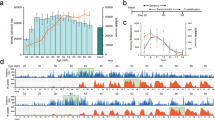Abstract.
The transition from an amorphous subsong into mature song requires a series of vocal changes. By tracing song elements during development, we have shown that the imitation trajectory to the target could not be predicted based on monotonic progression of vocal changes, indicating an internal component that imposes constraints on song development. Here we further examine the nature of constraints on song imitation in the zebra finch. We first present techniques for identifying and tracing distinctive vocal changes, and then we examine how sequences of vocal change are expressed and coordinated. Examples suggest two types of constraints on song imitation, based on the nature of the temporal context. Developmentally diachronic constraints are imposed by sequential dependencies between vocal changes as a function of developmental time, whereas developmentally synchronic constraints are given by the acoustic context of notes within the song. Finally, we show that the tendency of birds to copy certain sounds in the song model before others might be related to such constraints. We suggest that documenting the full range of distinctive vocal changes and the coordination of their expression would be useful for testing mechanisms of vocal imitation.
Similar content being viewed by others
Author information
Authors and Affiliations
Additional information
Electronic Publication
Rights and permissions
About this article
Cite this article
Tchernichovski, .O., Mitra, .P. Towards quantification of vocal imitation in the zebra finch. J Comp Physiol A 188, 867–878 (2002). https://doi.org/10.1007/s00359-002-0352-4
Received:
Revised:
Accepted:
Issue Date:
DOI: https://doi.org/10.1007/s00359-002-0352-4




